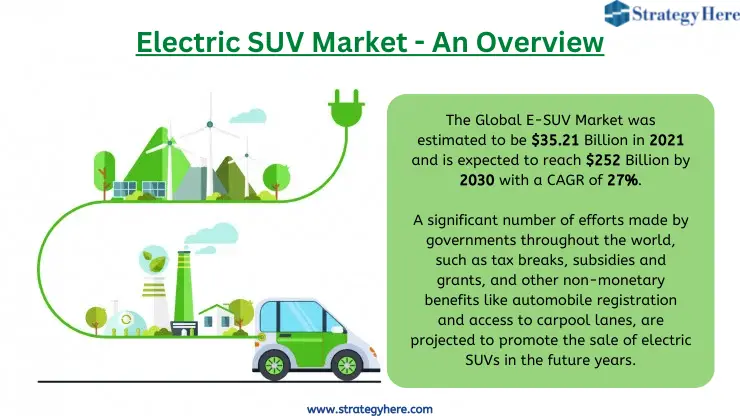The Global E-SUV Market was estimated to be $35.21 Billion in 2021 and is expected to reach $252 Billion by 2030 with a CAGR of 27%.
A significant number of efforts made by governments throughout the world, such as tax breaks, subsidies and grants, and other non-monetary benefits like automobile registration and access to carpool lanes, are projected to promote the sale of electric SUVs in the future years.
For example, in November 2019, German automakers increased payment incentives for electric vehicles in order to shift away from combustion engines and toward battery-powered engines in order to minimize hazardous emissions. Nations such as the United States, China, and many European countries have seen considerable rises in the sale of electric vehicles in recent decades, which will add to market expansion.
However, the absence of charging infrastructure, along with the expensive initial investment necessary to build an EV charging infrastructure, is undoubtedly constraining the growth of the electric SUV industry, according to a report by the market intelligence consulting, Strategy Here.
The significant preference of customers for this class has helped the market development with the greatest possible share. However, hybrid SUV cars will experience substantial increases throughout the projection period of 2021 – 2030. Hybrid SUVs are powered by two engines: one gasoline and one electric. They collaborate to turn the wheels. Less gasoline is consumed as a result, and fuel efficiency increases. The primary contrast between a hybrid and an electric car is that the hybrid's wheels are powered by both an internal combustion engine and electric motors. While hybrid vehicles are more fuel efficient and drive a longer fuel range.
During the forecasted years, the Asia-Pacific area is expected to have the fastest CAGR. Some of the factors driving the Asia-Pacific electric SUV market include the availability of economical local resources, strong state backing, and developing economies in the area, which are likely to enhance market growth, particularly in countries such as China and India. SUVs climbed from 12.59% of India's passenger vehicle (PV) market in 2010-11 to 25.01% in 2016-2017, according to the Society of Indian Automobile Manufacturers. Furthermore, SUVs are predicted to account for around 40% of India's EV industry during the next decade.
Europe is one of the leading areas in the electric SUV market due to the existence of strong government rules to minimize carbon emissions. SUV demand shows no signs of abating, and Europe is catching up to the United States and China in terms of growing popularity. According to a report by the market intelligence consulting, Strategy Here, SUVs were the most popular car segment in Europe. As a result, all of these factors will drive future demand for Europe's electric SUV industry.
BMW Group, Ford Motor Company, BYD Company Limited, Daimler AG, Volkswagen AG, Honda Motor Co., Ltd., Groupe Renault, Tata Motors, Kia Corporation, Tesla, and Volvo Car Corporation make up the leading suppliers.







